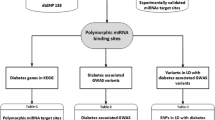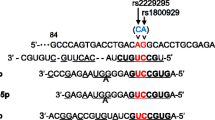Abstract
MicroRNAs are small single-stranded molecules that have emerged as important genomic regulators in different pathways. Different studies have shown that they are implicated in the metabolism and glucose homeostasis, and therefore, they could also be involved in the pathogenesis of metabolic disorders such as type 2 diabetes (T2DM). The aim of this study was to verify whether genetic variations in candidate microRNA (miRNA or miR) genes could contribute to T2DM susceptibility. We have selected 13 miRNAs as candidate loci according to literature data and to a computational analysis. MicroRNA genes were analyzed by direct sequencing in a cohort of 163 Italian T2DM patients and 185 healthy controls. We identified 6 novel variants never described before and 9 SNPs already described in databases. Five newly identified variants were found only in the cases group. We performed a case/control association study to test the associations of particular alleles/genotypes of identified SNPs with the disease. Two polymorphisms were associated with T2DM susceptibility: in particular, the G allele of rs895819 in hsa-mir-27a has shown a significantly protective effect (OR = 0.58 and P = 0.008), while the G allele of rs531564 in hsa-mir-124a appears to be a risk allele (OR = 2.15, P = 0.008). This is the first report indicating that genetic polymorphisms in miRNA regions could contribute to T2DM susceptibility.
Similar content being viewed by others
References
Muhonen P, Holthofer H (2009) Epigenetic and microRNA-mediated regulation in diabetes. Nephrol Dial Transplant 24(4):1088–1096
Rottiers V, Näär AM (2012) MicroRNAs in metabolism and metabolic disorders. Nat Rev Mol Cell Biol 13(4):239–250
Heneghan HM, Miller N, Kerin MJ (2010) Role of microRNAs in obesity and the metabolic syndrome. Obes Rev 11(5):354–361
Lewis BP, Burge CB, Bartel DP (2005) Conserved seed pairing, often flanked by adenosines, indicates that thousands of human genes are microRNA targets. Cell 120(1):15–20
Krek A, Grün D, Poy MN, Wolf R, Rosenberg L, Epstein EJ, MacMenamin P, da Piedade I, Gunsalus KC, Stoffel M, Rajewsky N (2005) Combinatorial microRNA target predictions. Nat Genet 37(5):495–500
Fernandez-Valverde SL, Taft RJ, Mattick JS (2011) MicroRNAs in β-cell biology, insulin resistance, diabetes and its complications. Diabetes 60(7):1825–1831
Kim YJ, Hwang SJ, Bae YC, Jung JS (2009) MiR-21 regulates adipogenic differentiation through the modulation of TGF-beta signaling in mesenchymal stem cells derived from human adipose tissue. Stem Cells 27:3093–3102
Betel D, Wilson M, Gabow A, Marks DS, Sander C. (2008) The microRNA.org resource: targets and expression. Nucleic Acids Res 36(Database Issue): D149–53
Poy MN, Eliasson L, Krutzfeldt J, Kuwajima S, Ma X, Macdonald PE, Pfeffer S, Tuschl T, Rajewsky N, Rorsman P, Stoffel M (2004) A pancreatic islet-specific microRNA regulates insulin secretion. Nature 432(7014):226–230
Li Y, Xu X, Liang Y, Liu S, Xiao H, Li F, Cheng H, Fu Z (2010) miR-375 enhances palmitate-induced lipoapoptosis in insulin-secreting NIT-1 cells by repressing myotrophin (V1) protein expression. Int J Clin Exp Pathol 3:254–264
Plaisance V, Abderrahmani A, Perret-Menoud V, Jacquemin P, Lemaigre F, Regazzi R (2006) MicroRNA-9 controls the expression of Granuphilin/Slp4 and the secretory response of insulin-producing cells. J Biol Chem 281(37):26932–26942
Ciccacci C, Di Fusco D, Cacciotti L, Morganti R, D’Amato C, Novelli G, Sangiuolo F, Spallone V, Borgiani P. (2012) TCF7L2 gene polymorphisms and type 2 diabetes: association with diabetic retinopathy and cardiovascular autonomic neuropathy. Acta Diabetol. doi:10.1007/s00592-012-0418-x
Baroukh N, Ravier MA, Loder MK, Hill EV, Bounacer A, Scharfmann R, Rutter GA, Van Obberghen E (2007) MicroRNA-124a regulates Foxa2 expression and intracellular signaling in pancreatic beta-cell lines. J Biol Chem 282(27):19575–19588
Lovis P, Gattesco S, Regazzi R (2008) Regulation of the expression of components of the exocytotic machinery of insulin-secreting cells by microRNAs. Biol Chem 389(3):305–312
Gauthier BR, Wollheim CB (2006) MicroRNAs: ‘ribo-regulators’ of glucose homeostasis. Nat Med 12(1):36–38
Balasubramanyam M, Aravind S, Gokulakrishnan K, Prabu P, Sathishkumar C, Ranjani H, Mohan V (2011) Impaired miR-146a expression links subclinical inflammation and insulin resistance in Type 2 diabetes. Mol Cell Biochem 351(1–2):197–205
Herrera BM, Lockstone HE, Taylor JM, Wills QF, Kaisaki PJ, Barrett A, Camps C, Fernandez C, Ragoussis J, Gauguier D, McCarthy MI, Lindgren CM (2009) MicroRNA-125a is over-expressed in insulin target tissues in a spontaneous rat model of Type 2 diabetes. BMC Med Genomics 2:54
John B, Enright AJ, Aravin A, Tuschl T, Sander C, Marks DS (2004) Human MicroRNA targets. PLoS Biol 2(11):e363
Griffiths-Jones S, Saini HK, van Dongen S, Enright AJ. (2008) miRBase: tools for microRNA genomics. Nucleic Acids Res 36(Database issue):D154–8
Lall S, Grün D, Krek A, Chen K, Wang YL, Dewey CN, Sood P, Colombo T, Bray N, Macmenamin P, Kao HL, Gunsalus KC, Pachter L, Piano F, Rajewsky N (2006) A genome-wide map of conserved microRNA targets in C. elegans. Curr Biol 16(5):460–471
Kim SY, Kim AY, Lee HW, Son YH, Lee GY, Lee JW, Lee YS, Kim JB (2010) miR-27a is a negative regulator of adipocyte differentiation via suppressing PPARgamma expression. Biochem Biophys Res Commun 392(3):323–328
Sun Q, Gu H, Zeng Y, Xia Y, Wang Y, Jing Y, Yang L, Wang B (2010) Hsa-mir-27a genetic variant contributes to gastric cancer susceptibility through affecting miR-27a and target gene expression. Cancer Sci 101(10):2241–2247
McGregor RA, Choi MS (2011) MicroRNAs in the regulation of adipogenesis and obesity. Curr Mol Med 11(4):304–316
Baroukh NN, Van Obberghen E (2009) Function of microRNA-375 and microRNA-124a in pancreas and brain. FEBS J 276(22):6509–6521
Qi L, Hu Y, Zhan Y, Wang J, Wang BB, Xia HF, Ma X (2012) A SNP site in pri-miR-124 changes mature miR-124 expression but no contribution to Alzheimer’s disease in a Mongolian population. Neurosci Lett 515(1):1–6
Acknowledgments
This study was supported by grants from Fondazione Roma 2008. Laura Cacciotti and Carla Greco are trainees of the Specialization School for Nutritional Sciences, Tor Vergata University, Rome, Italy.
Conflict of interest
None.
Author information
Authors and Affiliations
Corresponding author
Additional information
Communicated by Renato Lauro.
Electronic supplementary material
Below is the link to the electronic supplementary material.
Rights and permissions
About this article
Cite this article
Ciccacci, C., Di Fusco, D., Cacciotti, L. et al. MicroRNA genetic variations: association with type 2 diabetes. Acta Diabetol 50, 867–872 (2013). https://doi.org/10.1007/s00592-013-0469-7
Received:
Accepted:
Published:
Issue Date:
DOI: https://doi.org/10.1007/s00592-013-0469-7




